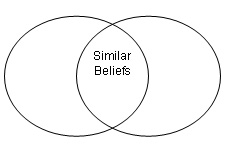Suggested Activities
Students examine the dynamic nature of liberalism and determine which liberal principles and values have remained constant over time. Students explore the initial expressions of liberalism before examining contemporary political figures to determine the degree to which each figure embodies the core values of liberal ideology.
- Identify principles of liberalism that have remained constant over time.
Explore the evolution of language
To introduce the changing nature of liberalism, invite students to explore the meaning of common words whose meanings have shifted over time. Ask students to think of words that they and their parents would define differently. Examples might include pad, coke, mouse and platform. Alternatively, provide students with examples of words that meant something different in the past than they do now (see References). Extend these examples to the study of liberalism by explaining that the meaning of the term liberalism has also changed over time.
Identify principles of liberalism
Indicate that the term liberalism has had different meanings in historical and contemporary contexts. Despite the changes over time, liberalism as an ideology has retained some core principles and values that reflect a particular view of human nature and the role of governments in society. Inform students that their challenge will be to identify principles and values of liberalism that have remained constant over time by examining the ideas of several important liberal figures. Students may examine these examples:
|
Group A—Historical
- John Locke
- John Stuart Mill
- Jeremy Bentham
- Adam Smith
- Montesquieu
- Iroquois Confederacy
|
Group B—Contemporary
- James Tobin
- Pierre Trudeau
- Tommy Douglas
- John Kenneth Galbraith
- John Maynard Keynes
- John F. Kennedy
- Milton Friedman
- Chief Clarence Louis.
|
To meet diverse learning needs, you may wish to provide students with a list of principles of liberalism including the following:
- individual rights and freedoms
- self-interest
- competition
- economic freedom
- rule of law
- private property.
Compare liberal thought
Arrange students in small groups. Provide each group with readings by (30-1) or about (30-2) several liberal figures. The readings should address their beliefs about human nature and the role of government in a civilized society. Ask the groups to assign each member a historical figure, such as the ones listed in Group A, and a contemporary one, such as those in Group B. Encourage students to do additional reading from authorized resources or from reliable Internet sites. Students could also be encouraged to work collaboratively with those from other groups who are responsible for the same liberal figures.
Suggest that students use an overlapping Venn diagram to organize key ideas from the two thinkers (see diagram below). In the centre, students are to place similarities in beliefs about government and human nature.
Historical Thinker (Group A) Contemporary Thinker (Group B)

You may wish to refer to Venn Diagrams (Support Material) to structure this activity.
Once students have completed their assigned Venn diagrams, ask the groups to reconvene to share their results. Remind students that they are to identify the fundamental beliefs about human nature and the role of government that have remained consistent over time.
-
- Determine the degree to which contemporary political figures reflect a liberal ideology.
Identify principles and values of liberalism
To check student understanding of the principles and values that underlie liberalism, invite them to assess the degree to which contemporary thinkers reflect a liberal perspective. For example, you may wish to ask students to read a speech given by John Ralston Saul on democracy and globalization (see References) and guide them in identifying evidence in the speech that indicates Saul does or does not reflect a liberal perspective. You may wish to refer to the basic authorized resources or other sources for examples.
Invite students to share their decisions and to review the principles and values of liberalism that informed their decisions and that could be described as core to the ideology.
Research contemporary political figures
Invite students to form small groups. Provide each group with a list of six prominent contemporary political figures––two who are generally considered to be liberals (e.g., Jean Chrétien, Brendan Nelson (Australia), a prominent member of the Liberal Party of Britain, a prominent member of the Liberal Party of British Columbia), two who claim not to be liberals (e.g., George W. Bush, Ralph Klein, Stephen Harper) and two First Nations leaders who are politically active but may not be aligned with a political party (e.g., Phil Fontaine, Elijah Harper).
Invite each student in the group to select one of the individuals to research. You may wish to encourage students from various groups who are researching the same individual to work collaboratively to gather information. Suggest students use the Internet to conduct research.
Place contemporary figures on a continuum of liberal ideology
Invite students to share their findings with the rest of the group. Instruct groups to place each individual on a continuum from extreme liberal to moderate liberal to antiliberal. Remind students that they should use the previously identified principles and values of liberalism as criteria to help determine the degree to which each individual’s beliefs and actions are consistent with the ideology of liberalism.
Write summary statements on liberalism
Invite students to create three statements that reflect the principles and values of liberalism. Remind students to include key aspects such as beliefs about human nature and the role of government.
|








